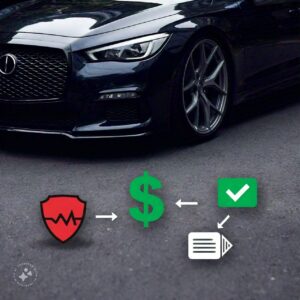Introduction
Owning a car is a significant milestone, but along with this achievement comes the responsibility of ensuring your vehicle is protected. Car insurance is more than just a legal requirement; it is a safety net that protects you, your vehicle, and others on the road. Yet, the world of car insurance can seem complex, with various terms, coverage options, and costs to consider. This article aims to simplify car insurance, helping you understand its importance, the different types of coverage, and how to make the best choices for your needs.

Why is Car Insurance Important?
Car insurance serves multiple purposes, all of which revolve around protecting your financial and legal well-being. Here are the key reasons why car insurance is essential:
- Legal Requirement: In most countries, car insurance is mandatory. Driving without insurance can lead to hefty fines, license suspension, or even legal action.
- Financial Protection: Accidents can lead to expensive repairs or medical bills. Insurance ensures you’re not left bearing these costs alone.
- Peace of Mind: Knowing you’re covered in case of unexpected incidents allows you to drive with confidence.
- Protection for Others: Insurance covers damage to third-party property or injuries to others involved in an accident.
Types of Car Insurance Coverage
Understanding the types of car insurance coverage is crucial to tailoring your policy to your needs. Here are the main types:
1. Liability Coverage
This is the most basic and legally required form of car insurance. It covers:
- Bodily Injury Liability: Costs related to injuries sustained by others in an accident you cause.
- Property Damage Liability: Repairs or replacement of another person’s property damaged in an accident.
2. Collision Coverage
Collision coverage pays for damage to your own car resulting from an accident, regardless of who is at fault.
3. Comprehensive Coverage
This type of coverage protects against non-collision-related damages such as theft, vandalism, natural disasters, or falling objects.
4. Personal Injury Protection (PIP)
PIP covers medical expenses for you and your passengers, regardless of fault. It may also cover lost wages and other related costs.
5. Uninsured/Underinsured Motorist Coverage
This protects you if you’re involved in an accident caused by a driver with no insurance or insufficient coverage.
6. Gap Insurance
If your car is totaled and the insurance payout is less than what you owe on your loan or lease, gap insurance bridges the difference.
Factors That Influence Your Car Insurance Premium
Your car insurance premium isn’t a fixed amount. Several factors influence how much you’ll pay, including:
- Driving Record: A clean driving history often leads to lower premiums, while accidents or traffic violations can increase rates.
- Age and Gender: Younger drivers, particularly males, tend to pay higher premiums due to perceived higher risk.
- Location: Urban areas with higher traffic and crime rates typically have higher premiums than rural areas.
- Vehicle Type: Luxury cars or vehicles with high repair costs generally have higher insurance premiums.
- Coverage Amount: Opting for additional coverage increases your premium.
- Credit Score: In some regions, a better credit score can result in lower premiums.
- Usage: How often and for what purpose you use your car (personal or commercial) can impact your premium.
Tips for Choosing the Right Car Insurance
Selecting the right car insurance policy can be daunting. Here are practical tips to help you make an informed decision:
- Assess Your Needs: Determine what coverage types and limits are essential based on your driving habits and financial situation.
- Compare Quotes: Obtain quotes from multiple insurance providers to find the best deal.
- Check the Deductible: Choose a deductible amount you can afford. A higher deductible usually means lower premiums but higher out-of-pocket costs in case of a claim.
- Understand the Policy: Read the policy terms carefully to know what is and isn’t covered.
- Ask About Discounts: Inquire about discounts for safe driving, bundling policies, or installing safety devices in your vehicle.
- Review the Insurer’s Reputation: Choose a provider known for good customer service and hassle-free claims processing.
Common Misconceptions About Car Insurance
Car insurance is often surrounded by myths and misconceptions. Let’s debunk some common ones:
Myth 1: Red Cars Are More Expensive to Insure
The color of your car has no bearing on your insurance premium. Rates are influenced by the make, model, and other factors.
Myth 2: Older Cars Don’t Need Comprehensive Coverage
While older cars may not require comprehensive coverage, it’s still worth considering if repairs or replacements would be costly for you.
Myth 3: Insurance Covers Everything
No policy covers every possible incident. Be sure to understand your policy’s exclusions.
Myth 4: Minor Accidents Don’t Need to Be Reported
Failing to report accidents could lead to complications in future claims. Always inform your insurer, even for minor incidents.
Steps to File a Car Insurance Claim
Filing a claim can seem intimidating, but knowing the process can make it smoother:
- Contact Your Insurer: Notify your insurance company as soon as possible after the incident.
- Document the Scene: Take photos of the accident, damages, and any other relevant details.
- Gather Information: Collect information from the other driver(s), including their insurance details, license plate number, and contact information.
- Submit Necessary Documents: Provide the required paperwork, such as a police report or repair estimates.
- Follow Up: Stay in touch with your insurer to track the progress of your claim.
Conclusion
Car insurance is an essential aspect of responsible car ownership, offering financial protection and peace of mind in unforeseen circumstances. By understanding the types of coverage, factors affecting premiums, and how to choose a policy, you can navigate the car insurance landscape with confidence. Remember, a well-informed decision not only saves money but ensures adequate protection for you and your vehicle.
Stay proactive, compare your options, and prioritize coverage that meets your needs. With the right car insurance policy, you’re not just insuring your car; you’re safeguarding your future.

